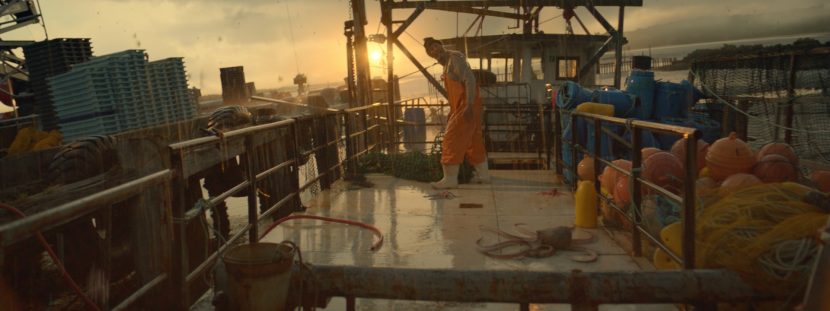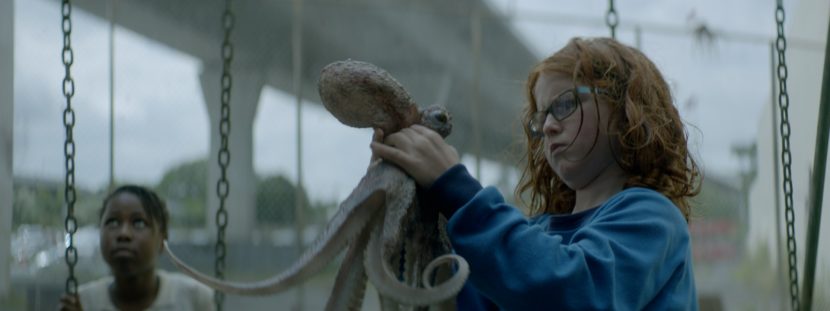After seeing this great new spot, fxguide spoke to Deluxe’s Method Studios Senior VFX Supervisor Benjamin Walsh about how they made it rain octopuses.
https://www.youtube.com/watch?v=SQ_blyWcQoQ
fxg: Are they are ‘real’ (prop) octopuses in the spot ?
The art department created 200 practical silicon octopuses that were intended for any foreground interaction. They shot the octopuses out of two compression cannons but only hit a small surface area of the set. Additionally, this only filled about 1 second of a standard 3 second shot. Method had to augment the shots with CG octopuses in the background all the way to the horizon to achieve depth, plus fill the additional time.
During the shoot it also became clear that there would need to be a hero CG octopus with specific choreography that was too difficult to achieve in camera. Method modeled our CG off the hero practical octopus so there was seamless consistency in the look, color and behavior of the practical and CG creatures.
fxg: Was a octopus a soft body or rag doll type sim or was it key framed?
Houdini was our obvious choice for the background raining octopuses, but Houdini’s FEM solver was also great to give each octopus a fleshy feeling. We did hand-animate some octopuses in Maya, but subsequently simulated their squishiness in Houdini as well. There’s something organic about the octopuses that we felt looked better when they got that extra squishy treatment.
In addition to the octopus rain tool, we created a custom “sticky” octopus rig in Houdini, with which we could dial how long the octopuses stuck onto surfaces for. This had nice random attributes like how many octopuses would stick onto a given surface. We also had a bouncing setup to match how much the practical octopuses bounced on set. Depending on the shot, we used multiple passes of animation and sims.

fxg: For secondary action, such as a chair being slightly knocked at the wedding – was there on set rigs or was this done in post?
We rigged practical pieces for some shots and we also identified any accidental prop movement from talent interaction and we would animate our CG to time perfectly.
fxg: Which renderer did you use? I assume there was some SSS tweaking for the flesh…
We rendered in Mantra for ease of integration with CG rain and octopuses. The lighters only had to deal with the SSS in close up CG shots.
fxg: Was the rain digitally added? I know rain can be hard to read on screen, even it is very wet on set.
Yes, the rain was CG — a number of shots were captured on sunny days in Auckland, so we were required to flatten out the lighting and replace the skies before adding rain. Working with colorist Stefan Sonnenfeld at Deluxe’s Company 3 made this process much easier as he gave us a great starting point with the graded plate and the added flexibility of working under a LUT which keeps all the information in the plate so we can manipulate even further to achieve the desired look.
For the plane shots, Method created a CG plane, CG clouds and rain, additional atmospheric effects, plus the CG octopuses. This was a challenge since we were trying to create the feeling of being in a storm but wanted to be able to clearly read the octopus amongst the chaos in a very short timeframe.

fxg: How long was the shoot? It seems like quite a few setups and locations, but I assume that the tracking would have been fairly easy since most octopuses are airborne…
We had 4 shoot days in New Zealand. Tracking shots that only had far background CG octopuses was very straightforward but for any shots that required mid or foreground CG octopuses, we had to create geometry (ground, buildings) for their interaction.
fxg: What were the tech specs please and the pipeline?
The commercial was shot on Alexa XT with a combination of anamorphic and spherical lenses. Method used several techniques to create the world of raining octopuses, as many of the shots needed bespoke octopuses. First, we used the live action plates in addition to photographic reference from set for character and motion studies. We modeled the octopuses in Maya and Zbrush, and then using Method’s custom pipeline tools, made them available for our Houdini FX artists.
The look development for the octopuses was done in Mantra, so we could stay mostly within Houdini. This gave us a lot of flexibility — FX could pick up real lighting and shaders, and lighting could pull the FX directly into their scenes.
fxg: And, finally, did you ever just stop and say ‘I have the weirdest job in the world? Raining Octopuses?!!??’
We have been lucky enough to collaborate with BBDO and GE on a number of unusually creative commercials so the expectation is always for a unique and fantastical concept…which is refreshing every time.
Credits: GE “Raining Octopuses”
Agency: BBDO NY
Production: Biscuit Filmworks
Director: Christopher Riggert
DP: Jeremy Rouse
Visual Effects: Method Studios
Executive Producer: Stephanie Gilgar
Producer: Scott Boyajan, Heather Saunders
Senior VFX Supervisor: Benjamin Walsh
VFX Supervisor: Doug Luka
CG Supervisor: Margaret Bright-Ryan, Ivan Guerrero
Animation Supervisor: Keith Roberts
DFX Supervisor: Sandro Blattner
2D Lead: Ian Holland
Nuke Lead: Chris Bankoff
Modeling Supervisor: Lersak Bun
Rigging Supervisor: Simon Yuen
FX Supervisor: Dan Bodenstein
Color: Company 3
Colorist: Stefan Sonnenfeld
